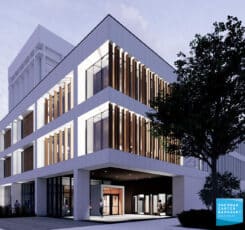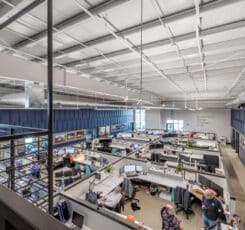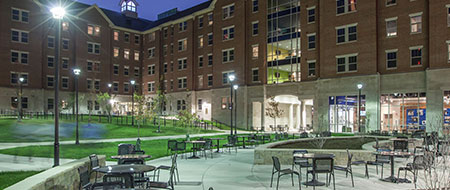It’s been more than 10 years in the making. And on the count of three, Taylor County Schools’ vision of building new schools started to take shape last Wednesday as officials broke ground for the new Taylor County High School.
“This is not something you get to do but once every 50 to 75 years,” Superintendent Roger Cook said during a ceremony at the project site on KY 210.
Cook said his education career started in 1958 at Taylor County Elementary School and is proud that he will end it at the same district when he retires.
He told the crowd that while he is glad to be a small part of setting the district’s facilities plan in motion, the local community’s support of the nickel tax and those in Frankfort who helped secure funding played a much larger role.
“This is all about one thing – our children and the education of our children,” Cook said.
Board Chair Tony Davis said discussion of new schools started about 10 years ago amongst himself and fellow board members Lillian Clark and Jim Cheatham. And when Deanna Hunt and David Hall came onto the board a few years later, he said they joined right in to support the effort.
“I really didn’t think it would ever happen. After 10 years it gets a little discouraging,” Davis said. “But I found out one thing, we can put politics aside and work together and get a lot of things done.”
Cheatham said that after waiting so long, he is thankful that new schools are finally coming.
Clark retired from the district after 28 years of teaching and working in the guidance office. She has served on the board for nearly 20 years.
“This is one of the proudest moments of my life,” Clark said. “I am really, really hoping that these buildings come up very fast and that we get our children in these schools.”
Hunt agrees. When she ran for election four years ago, Hunt said the idea of new schools wasn’t very popular, but she made her support of it widely known without hesitation.
“This has been the most rewarding thing I’ve ever done besides my children – this is it,” she said.
The district facilities plan calls for building a pre-school through second grade building on the current middle and high school campus and a new high school on the district’s KY 210 property. The middle and high school buildings will be remodeled, with the current Taylor County Middle School building housing grades three through five, and the current Taylor County High School building housing the middle school. The current elementary school building would no longer be used.
“This is the beginning,” Cook said. “On Nov. 4, we open the bids for our primary center, and our primary center will be about one month behind this.”
Cook said the bids were staggered in hopes of receiving low bids on both projects. And with the lowest bids for a high school that he has seen in several years, according to Sherman Carter Barnhart Architect Kenny Stanfield, Cook said he is hoping the same will happen for the primary center.
“The lower the bids, the more we can get for our children and our students,” Cook said.
According to Cook, new school facilities will be an economic boost for the community. When he was superintendent of Russellville Independent Schools, Cook said a factory was considering locating there or to a city in Tennessee. The decision eventually came down to one factor – the quality of the schools. And with new school facilities, Cook said the factory chose Russellville.
“It will do the same thing here,” Cook said. “When you have people who want to locate here, they want nice schools [for their children] to go to. And we have two good school systems.”
State Rep. John “Bam” Carney, R-Campbellsville, said that as a graduate and employee of the district, as well as a father to students who attend the district’s schools, it has been an honor to participate in the project.
For many years in Frankfort, Carney said a lot of school projects received funding without any financial support from the local community. But with the tightening of the state’s budget, he said that practice has ended.
“It became very clear in Frankfort … that in order to build schools anymore, local investment must be made first, and that’s how it should be,” Carney said.
He said he is convinced that the groundbreaking for the new high school wouldn’t have happened had the local community not done the “right thing” by passing the nickel tax.
Revenue generated from the nickel tax will be matched by the state and used to fund the construction of new schools as laid out in the district facilities plan.
Kristi Culpepper, executive director of the School Facilities Construction Commission, also attended the ceremony. She praised the community for not petitioning the board’s decision to levy the nickel tax last year.
“It is difficult as an advocate for schools to go and ask the General Assembly for money when locals aren’t willing to make difficult decisions like that, but you all have and this is what you have to show for it,” Culpepper said.
In an email from Cook after the ceremony, he laid out the stages of the high school’s construction. Topsoil removal began Friday and construction trailers will be set up to house the project managers. Next, footers for the building will be dug and concrete poured for the foundation.
“They will then assemble the concrete forms to pour the walls of the building,” Cook wrote.
After that, the truss system for the roof will be assembled in preparation for the roof and brick will be laid on the outside of the building. Once the building is dried-in, meaning that the inside is protected from the outside weather, interior work can begin.
Hall said during the ceremony that the road to building new schools has been a difficult one with its share of ups and downs.
“But I think the primary thing we’re looking at is we all accept that children are our greatest asset, and we’ve come together as a community to recognize that this is what we want to do,” Hall said. “This is our investment in the future.”



